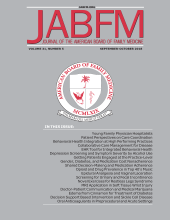Abstract
Purpose: Problem drug-related behavior (PDB) among patients on chronic opioid therapy may reflect an opioid use disorder. This study assessed PDB prevalence and the relationship between PDB and ongoing prescription of opioids at a primary care clinic that implemented a multifaceted opioid management program.
Methods: A chart review of patients in a chronic opioid registry assessed prevalence of different types of PDB over 2 years, and whether opioids were prescribed during the last 3 months of the 2-year study period among patients with different levels of PDB.
Results: Among 233 registry patients, 84.1% exhibited PDB; 45.5% exhibited ≥3 types of PDB. At the end of 2 years, most registry patients were still prescribed opioids, though patients with ≥3 types of PDB were less likely than those without PDB to be prescribed opioids (62.3% vs. 78.4%, P = 0.016).
Conclusions: PDB was pervasive in this population of patients on chronic opioid therapy. Those with the most PDB, and thus with the greatest likelihood of opioid use disorder and its social and medical consequences, were the least likely to be prescribed opioids by the clinic after 2 years. Given the rising rates of illicit opioid use in the U.S., it is important that clinics work closely with their patients who display PDB, systematically assess them for opioid use disorder, and offer evidence-based treatment.







